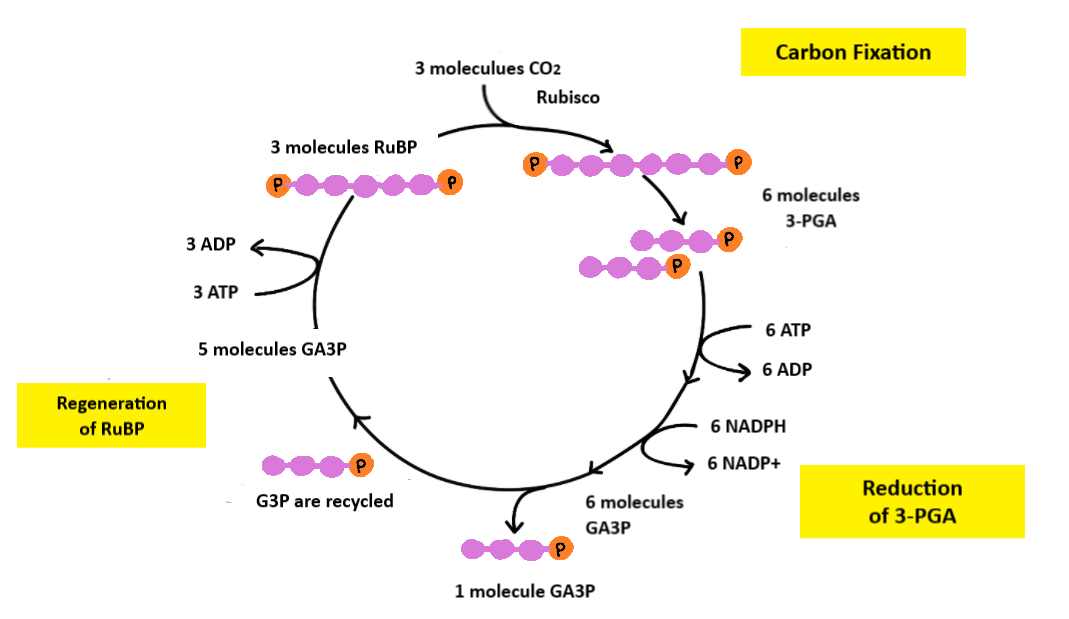
The end product of the Calvin cycle is
a. Ribulose bisphosphate
b. Phosphoglyceraldehyde (PGAL)
c. PEP carboxylase (PEP case)
d. Carbon dioxide
Answer
559.2k+ views
Hint: Plant’s produces and stores sucrose as starch. Calvin cycle works in three major steps that are carboxylation, reduction and regeneration to produce sucrose. During each step various products are made. The Calvin cycle consists of various chain reactions to produce sucrose.
Complete answer:
• Calvin cycle is carried out in all photosynthetic plants. Let’s go through all three stages of Calvin cycle.
• The first stage is carboxylation of RuBP (Rubisco bisphosphate). In which the atmospheric $CO_2$ gets fixed with RuBP to produce stable organic intermediate. This reaction is carried out by RuBP carboxylase enzyme and produces two molecules of 3-phosphoglycerate.
• The second stage is reduction. In this process, 2 molecules of ATP used for phosphorylation and two NADPH for reduction per $CO_2$. 3-phosphoglycerate gets converted into glyceraldehyde-3-phosphate or phosphoglyceraldehyde.
• Third stage is regeneration. After the six rounds of Calvin cycle, 2 molecules of PGAL goes for production of one molecule of glucose while another 15 PGAL goes for regeneration of 5-C RuBP that can be used to accept new carbon molecules. This process requires ATP.

Hence, the correct answer is option (B).
Note: Here the regenerated RuBP cannot be the end product because it undergoes regeneration. So the last product should be PGAL. The last product will sucrose instead of glucose because glucose cannot be transported directly to storage by plants. Plant stem can transport sucrose as it is non-reducing sugar and it does not react with oxygen while being transported in the stem for storage. The stored sucrose can be used during dormancy.
Complete answer:
• Calvin cycle is carried out in all photosynthetic plants. Let’s go through all three stages of Calvin cycle.
• The first stage is carboxylation of RuBP (Rubisco bisphosphate). In which the atmospheric $CO_2$ gets fixed with RuBP to produce stable organic intermediate. This reaction is carried out by RuBP carboxylase enzyme and produces two molecules of 3-phosphoglycerate.
• The second stage is reduction. In this process, 2 molecules of ATP used for phosphorylation and two NADPH for reduction per $CO_2$. 3-phosphoglycerate gets converted into glyceraldehyde-3-phosphate or phosphoglyceraldehyde.
• Third stage is regeneration. After the six rounds of Calvin cycle, 2 molecules of PGAL goes for production of one molecule of glucose while another 15 PGAL goes for regeneration of 5-C RuBP that can be used to accept new carbon molecules. This process requires ATP.

Hence, the correct answer is option (B).
Note: Here the regenerated RuBP cannot be the end product because it undergoes regeneration. So the last product should be PGAL. The last product will sucrose instead of glucose because glucose cannot be transported directly to storage by plants. Plant stem can transport sucrose as it is non-reducing sugar and it does not react with oxygen while being transported in the stem for storage. The stored sucrose can be used during dormancy.
Recently Updated Pages
Why are manures considered better than fertilizers class 11 biology CBSE

Find the coordinates of the midpoint of the line segment class 11 maths CBSE

Distinguish between static friction limiting friction class 11 physics CBSE

The Chairman of the constituent Assembly was A Jawaharlal class 11 social science CBSE

The first National Commission on Labour NCL submitted class 11 social science CBSE

Number of all subshell of n + l 7 is A 4 B 5 C 6 D class 11 chemistry CBSE

Trending doubts
10 examples of friction in our daily life

One Metric ton is equal to kg A 10000 B 1000 C 100 class 11 physics CBSE

Difference Between Prokaryotic Cells and Eukaryotic Cells

1 Quintal is equal to a 110 kg b 10 kg c 100kg d 1000 class 11 physics CBSE

State the laws of reflection of light

Explain zero factorial class 11 maths CBSE




